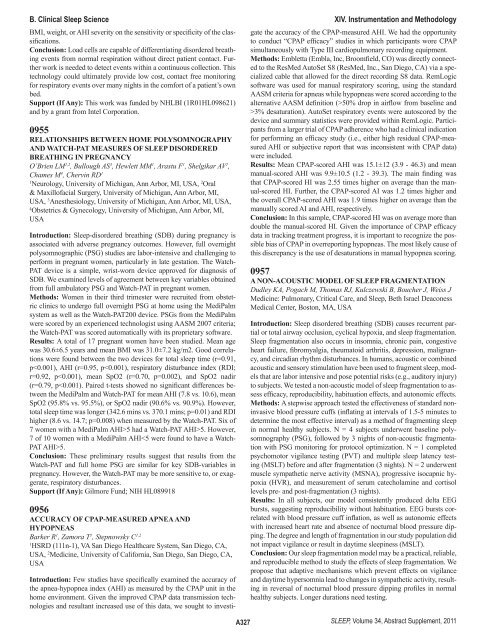SLEEP 2011 Abstract Supplement
SLEEP 2011 Abstract Supplement
SLEEP 2011 Abstract Supplement
Create successful ePaper yourself
Turn your PDF publications into a flip-book with our unique Google optimized e-Paper software.
B. Clinical Sleep Science XIV. Instrumentation and Methodology<br />
BMI, weight, or AHI severity on the sensitivity or specificity of the classifications.<br />
Conclusion: Load cells are capable of differentiating disordered breathing<br />
events from normal respiration without direct patient contact. Further<br />
work is needed to detect events within a continuous collection. This<br />
technology could ultimately provide low cost, contact free monitoring<br />
for respiratory events over many nights in the comfort of a patient’s own<br />
bed.<br />
Support (If Any): This work was funded by NHLBI (1R01HL098621)<br />
and by a grant from Intel Corporation.<br />
0955<br />
RELATIONSHIPS BETWEEN HOME POLYSOMNOGRAPHY<br />
AND WATCH-PAT MEASURES OF <strong>SLEEP</strong> DISORDERED<br />
BREATHING IN PREGNANCY<br />
O’Brien LM 1,2 , Bullough AS 3 , Hewlett MM 1 , Arastu F 1 , Shelgikar AV 1 ,<br />
Chames M 4 , Chervin RD 1<br />
1<br />
Neurology, University of Michigan, Ann Arbor, MI, USA, 2 Oral<br />
& Maxillofacial Surgery, University of Michigan, Ann Arbor, MI,<br />
USA, 3 Anesthesiology, University of Michigan, Ann Arbor, MI, USA,<br />
4<br />
Obstetrics & Gynecology, University of Michigan, Ann Arbor, MI,<br />
USA<br />
Introduction: Sleep-disordered breathing (SDB) during pregnancy is<br />
associated with adverse pregnancy outcomes. However, full overnight<br />
polysomnographic (PSG) studies are labor-intensive and challenging to<br />
perform in pregnant women, particularly in late gestation. The Watch-<br />
PAT device is a simple, wrist-worn device approved for diagnosis of<br />
SDB. We examined levels of agreement between key variables obtained<br />
from full ambulatory PSG and Watch-PAT in pregnant women.<br />
Methods: Women in their third trimester were recruited from obstetric<br />
clinics to undergo full overnight PSG at home using the MediPalm<br />
system as well as the Watch-PAT200 device. PSGs from the MediPalm<br />
were scored by an experienced technologist using AASM 2007 criteria;<br />
the Watch-PAT was scored automatically with its proprietary software.<br />
Results: A total of 17 pregnant women have been studied. Mean age<br />
was 30.6±6.5 years and mean BMI was 31.0±7.2 kg/m2. Good correlations<br />
were found between the two devices for total sleep time (r=0.91,<br />
p3% desaturation). AutoSet respiratory events were autoscored by the<br />
device and summary statistics were provided within RemLogic. Participants<br />
from a larger trial of CPAP adherence who had a clinical indication<br />
for performing an efficacy study (i.e., either high residual CPAP-measured<br />
AHI or subjective report that was inconsistent with CPAP data)<br />
were included.<br />
Results: Mean CPAP-scored AHI was 15.1±12 (3.9 - 46.3) and mean<br />
manual-scored AHI was 9.9±10.5 (1.2 - 39.3). The main finding was<br />
that CPAP-scored HI was 2.55 times higher on average than the manual-scored<br />
HI. Further, the CPAP-scored AI was 1.2 times higher and<br />
the overall CPAP-scored AHI was 1.9 times higher on average than the<br />
manually scored AI and AHI, respectively.<br />
Conclusion: In this sample, CPAP-scored HI was on average more than<br />
double the manual-scored HI. Given the importance of CPAP efficacy<br />
data in tracking treatment progress, it is important to recognize the possible<br />
bias of CPAP in overreporting hypopneas. The most likely cause of<br />
this discrepancy is the use of desaturations in manual hypopnea scoring.<br />
0957<br />
A NON-ACOUSTIC MODEL OF <strong>SLEEP</strong> FRAGMENTATION<br />
Dudley KA, Pogach M, Thomas RJ, Kulczewski B, Boucher J, Weiss J<br />
Medicine: Pulmonary, Critical Care, and Sleep, Beth Israel Deaconess<br />
Medical Center, Boston, MA, USA<br />
Introduction: Sleep disordered breathing (SDB) causes recurrent partial<br />
or total airway occlusion, cyclical hypoxia, and sleep fragmentation.<br />
Sleep fragmentation also occurs in insomnia, chronic pain, congestive<br />
heart failure, fibromyalgia, rheumatoid arthritis, depression, malignancy,<br />
and circadian rhythm disturbances. In humans, acoustic or combined<br />
acoustic and sensory stimulation have been used to fragment sleep, models<br />
that are labor intensive and pose potential risks (e.g., auditory injury)<br />
to subjects. We tested a non-acoustic model of sleep fragmentation to assess<br />
efficacy, reproducibility, habituation effects, and autonomic effects.<br />
Methods: A stepwise approach tested the effectiveness of standard noninvasive<br />
blood pressure cuffs (inflating at intervals of 1.5-5 minutes to<br />
determine the most effective interval) as a method of fragmenting sleep<br />
in normal healthy subjects. N = 4 subjects underwent baseline polysomnography<br />
(PSG), followed by 3 nights of non-acoustic fragmentation<br />
with PSG monitoring for protocol optimization. N = 1 completed<br />
psychomotor vigilance testing (PVT) and multiple sleep latency testing<br />
(MSLT) before and after fragmentation (3 nights). N = 2 underwent<br />
muscle sympathetic nerve activity (MSNA), progressive isocapnic hypoxia<br />
(HVR), and measurement of serum catecholamine and cortisol<br />
levels pre- and post-fragmentation (3 nights).<br />
Results: In all subjects, our model consistently produced delta EEG<br />
bursts, suggesting reproducibility without habituation. EEG bursts correlated<br />
with blood pressure cuff inflation, as well as autonomic effects<br />
with increased heart rate and absence of nocturnal blood pressure dipping.<br />
The degree and length of fragmentation in our study population did<br />
not impact vigilance or result in daytime sleepiness (MSLT).<br />
Conclusion: Our sleep fragmentation model may be a practical, reliable,<br />
and reproducible method to study the effects of sleep fragmentation. We<br />
propose that adaptive mechanisms which prevent effects on vigilance<br />
and daytime hypersomnia lead to changes in sympathetic activity, resulting<br />
in reversal of nocturnal blood pressure dipping profiles in normal<br />
healthy subjects. Longer durations need testing.<br />
A327<br />
<strong>SLEEP</strong>, Volume 34, <strong>Abstract</strong> <strong>Supplement</strong>, <strong>2011</strong>

















